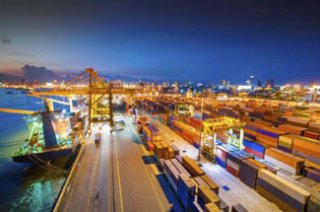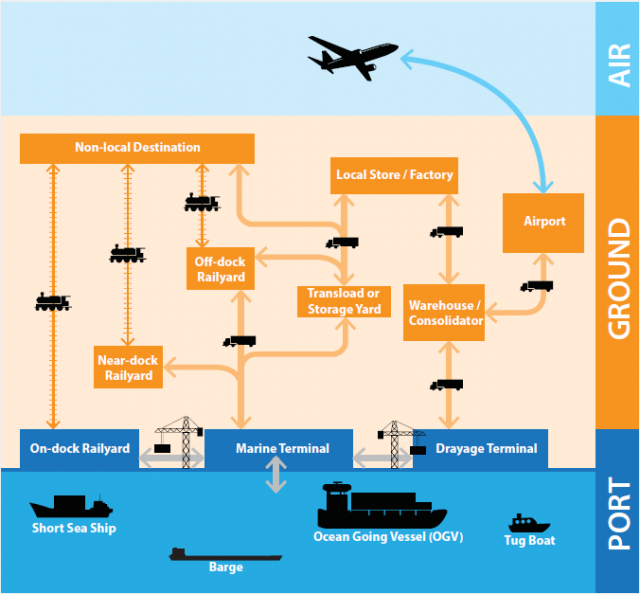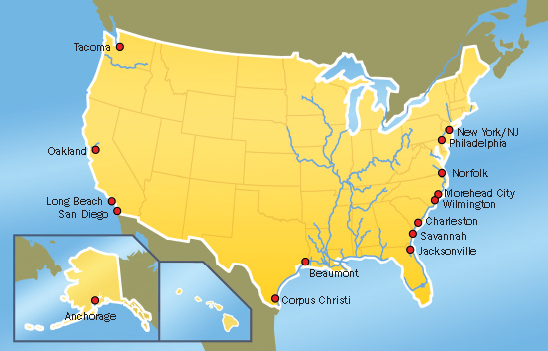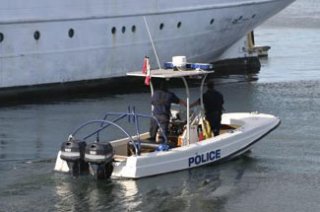Ports Primer: 2.1 The Role of Ports
Our nation’s ports are an important part of our national economy and intermodal transportation system. Over 95 percent of the cargo entering the United States arrives by ship, 1 and over 360 commercial ports nationwide help to transfer these goods to their destinations in communities across the nation.2 Our ports also serve as a significant resource for national defense and emergency preparedness.3 Understanding the role of ports can help residents more effectively engage with decisions that impact near-port communities.
In addition, to their impact on the national economy, ports also have an impact on local and regional economies. For more on these economic impacts, see Section 6 (Local and Regional Economy).
The focus of the Ports Primer is on ports, however, many considerations related to ports may also apply at large intermodal freight facilities that are not near waterways and which are sometimes referred to as inland ports. Additionally, while this Ports Primer emphasizes the goods movement aspect of port-related functions, many issues (e.g., idling ships) apply to travel/passenger aspects of port functions as well.
The National Economy

American ports are gateways for domestic and international trade. U.S. seaports handle over 99 percent of the country’s overseas cargo by volume and 65 percent by value, according to The American Association of Port Authorities (AAPA). 4 AAPA is a trade association representing public port authorities in the United States, Canada, the Caribbean and Latin America. These figures are significant, given that the value of all international trade accounts for nearly 30 percent of the U.S.
Gross Domestic Product (GDP) To meet increasing consumer demands, more ships are calling at U.S. seaports than ever before and the ships are getting bigger.5
Port and Port-Related Employment

In many communities, ports are significant sources of local employment. Ports are employers and also support employment in related sectors such as trucking and rail transportation. According to the American Association of Port Authorities, deepwater ports in the U.S. supported 541,946 jobs in 2014. The average salary for these workers was $54,273. In addition, port activity generated over 23 million jobs in related sectors and through their overall economic impact on the surrounding communities.6
Major Shipping Commodities7
Leading commodities shipped through U.S. ports include:
- Crude petroleum and petroleum products (such as gasoline, aviation fuel, natural gas)
- Chemicals and related products, including inorganic fertilizers
- Coal
- Food and farm products: wheat and wheat flour, corn, soybeans, rice, cotton, coffee
- Forest products: lumber, wood chips
- Iron and steel
- Soil, sand, gravel, rock, stone
Additional commodities shipped through U.S. ports include:
- Automobiles, automobile parts and machinery
- Clothing, shoes, electronics, toys
Ports handle a range of commodity mixes. Some ports focus on one type of commodity; some are more diversified.
Intermodal Transportation System

Ports serve as important transportation hubs that facilitate goods movement to businesses in local communities and worldwide markets. As illustrated in the figure at right, ports can connect goods to consumers through our highway system, railroads, air transit and domestic marine highways (water transportation routes). These ports include seaports as well as smaller intercoastal and inland ports that facilitate movement of goods between the seaports and local communities. Intermodal Transportation refers to movements of cargo between different kinds of transport modes.
As trade growth continues, ports are considering expanding their internal capacity by increasing efficiency and investing in infrastructure to support larger ships. Ports may also coordinate with communities, Metropolitan Planning Organizations, state and federal Departments of Transportation, and other agencies to expand transportation capacity outside the port to avoid bottlenecks created by limitations from other modes of transportation.
National Defense and Emergency Preparedness8
In addition to serving as economic drivers and transportation hubs, ports play an important role in national defense. Fifteen of our commercial seaports have been named Strategic Seaports by the U.S. Department of Defense (DOD) (see the map at right). These ports can help to support military deployments because

of their large staging areas, connections to rail infrastructure and ability to load non-containerized cargo. Ports can also use these capabilities to support emergency relief activities, such as from the Federal Emergency Management Agency, for natural disasters.
The DOD is particularly reliant on Strategic Seaports during military surge operations. For example, during Operation Iraqi Freedom, the DOD used these ports to load combat vehicles and aircraft. These operations require Strategic Seaports to have adequate rail infrastructure, significant staging areas for military cargo and workers skilled in handling non-containerized military equipment. As our commercial seaports continue to experience increasing levels of commercial containerized shipping, port staging areas and rail capacity to support military operations may be strained.
Homeland Security9

Security at ports is an important concern. With so much cargo traffic passing through, it is important for security measures to adequately monitor and protect the ports while still allowing an efficient flow of goods. Oversight and responsibilities for port security are divided between numerous actors and can be complex. In October 2005, the National Strategy for Maritime Security was approved by the President. This strategy provides plans that address preparedness, protection, response and recovery for both man-made and natural hazards that might create security concerns at our nation’s ports.
For more information: America’s Ports and Intermodal Transportation System (pdf)(6.9 MB, January 2009)











